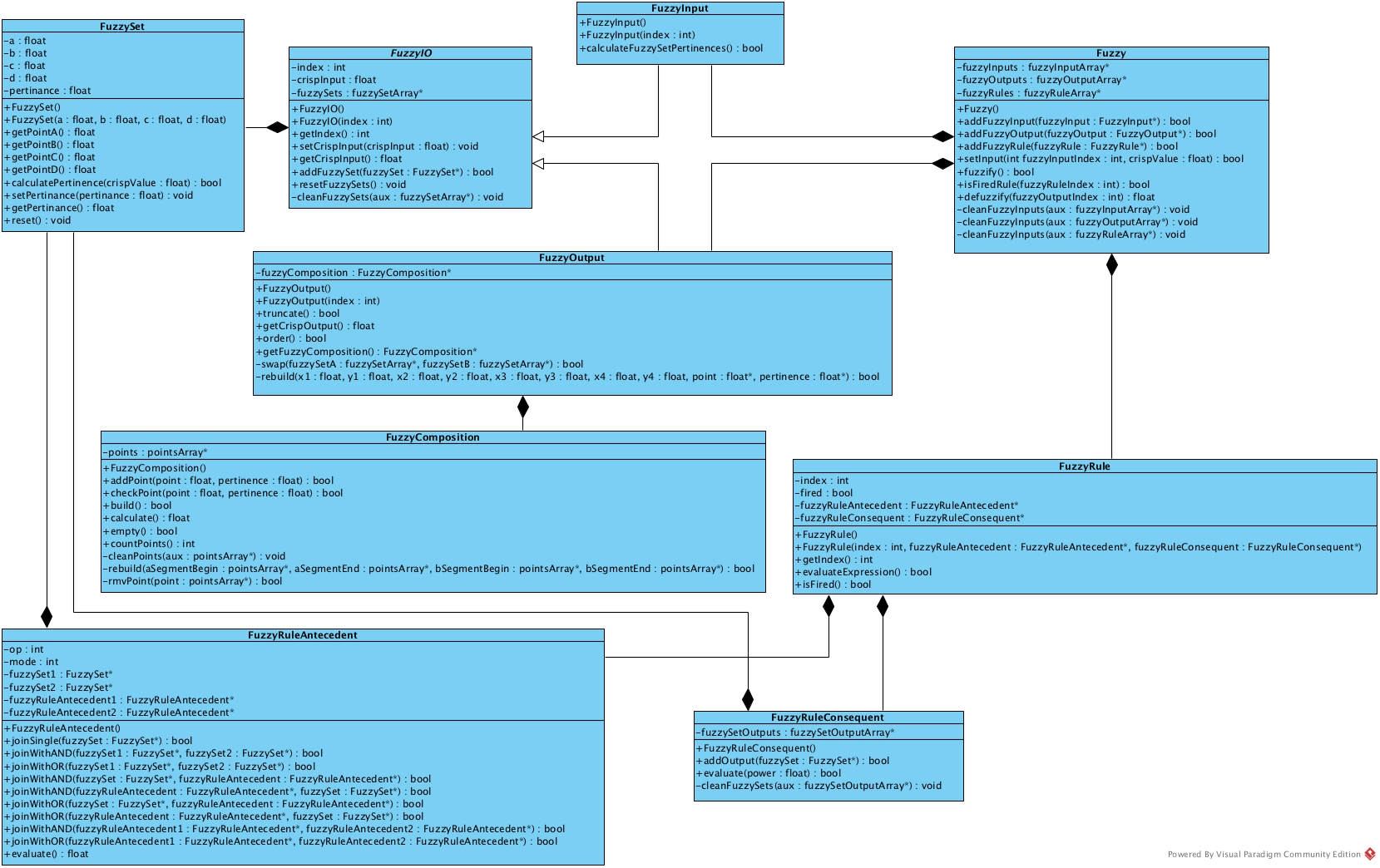eFLL (Embedded Fuzzy Logic Library) is a standard library for Embedded Systems to implement easy and efficient Fuzzy Systems.
Para informações avançadas, documentação e exemplos de uso em PORTUGUÊS: eFLL - Uma Biblioteca Fuzzy para Arduino e Sistemas Embarcados
For advanced information, documentation, and usage examples in ENGLISH: eFLL - A Fuzzy Library for Arduino and Embedded Systems
Written in C++/C, uses only standard C language library "stdlib.h", so eFLL is a library designed not only to Arduino, but any Embedded System or not how have your commands written in C.
It has no explicit limitations on quantity of Fuzzy, Fuzzy Rules, Inputs or Outputs, these limited processing power and storage of each microcontroller
It uses the process:
(MAX-MIN) and (Mamdani Minimum) for inference and composition, (CENTER OF AREA) to defuzzification in a continuous universe.
Tested with GTest for C, Google Inc.
Step 1: Go to the official project page on GitHub (Here)
Step 2: Make a clone of the project using Git or download at Download on the button "Download as zip."
Step 3: Clone or unzip (For safety, rename the folder to "eFLL") the files into some folder
Step 4: Compile and link it to your code (See Makefile)
Step 1: Open the Arduino IDE
Step 2: In main menu, go to SKETCH >> INCLUDE LIBRARY >> MANAGE LIBRARIES
Step 3: Search for "eFLL" or "Fuzzy"
Step 4: eFLL will appear in the list, to finish, just click in INSTALL, now you can include eFLL to your sketchs
Step 1: Go to the official project page on GitHub (Here)
Step 2: Make a clone of the project using Git or download at Download on the button "Download as zip."
Step 3: Clone or unzip (For safety, rename the folder to "eFLL") the files into Arduino libraries' folder:
Ubuntu (/usr/share/arduino/libraries/) if installed via apt-get, if not, on Windows, Mac or Linux (where you downloaded the Arduino IDE, the Library folder is inside)
Ok! The library is ready to be used!
If the installation of the library has been successfully held, to import the library is easy:
Step 4: Open your Arduino IDE, check out the tab on the top menu SKETCH → LIBRARY → Import eFLL
Fuzzy object - This object includes all the Fuzzy System, through it, you can manipulate the Fuzzy Sets, Linguistic Rules, inputs and outputs.
FuzzyInput object - This object groups all entries Fuzzy Sets that belongs to the same domain.
FuzzyOutput object - This object is similar to FuzzyInput, is used to group all output Fuzzy Sets thar belongs to the same domain.
FuzzySet object - This is one of the main objects of Fuzzy Library, with each set is possible to model the system in question. Currently the library supports triangular membership functions, trapezoidal and singleton, which are assembled based on points A, B, C and D, they are passed by parameter in its constructor FuzzySet(float a, float b, float c, float d).
FuzzyRule object - This object is used to mount the base rule of Fuzzy object, which contains one or more of this object. Instantiated with FuzzyRule fr = new FuzzyRule (ID, antecedent, consequent).
FuzzyRuleAntecedent object - This object is used to compound the object FuzzyRule, responsible for assembling the antecedent of the conditional expression of a FuzzyRule.
FuzzyRuleConsequent object - This object is used to render the object FuzzyRule, responsible for assembling the output expression of a FuzzyRule.
These are all eFLL library objects that are used in the process. The next step, generally interactive is handled by three methods of the Fuzzy Class first:
bool setInput(int id, float value);
It is used to pass the Crispe input value to the system note that the first parameter is the FuzzyInput object' ID which parameter value is intended.
bool fuzzify();
It is used to start the fuzzification process, composition and inference.
And finally:
float defuzzify(int id);
Authors: AJ Alves aj.alves@zerokol.com; Co authors: Dr. Ricardo Lira ricardor_usp@yahoo.com.br, Msc. Marvin Lemos marvinlemos@gmail.com, Douglas S. Kridi douglaskridi@gmail.com, Kannya Leal kannyal@hotmail.com
@mikebutrimov, @tzikis, @na7an
MIT License





